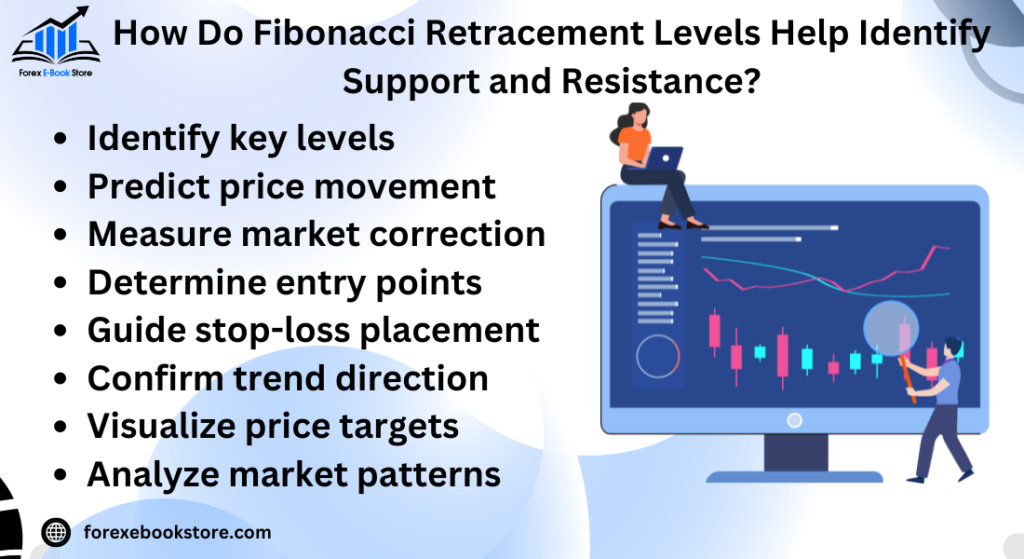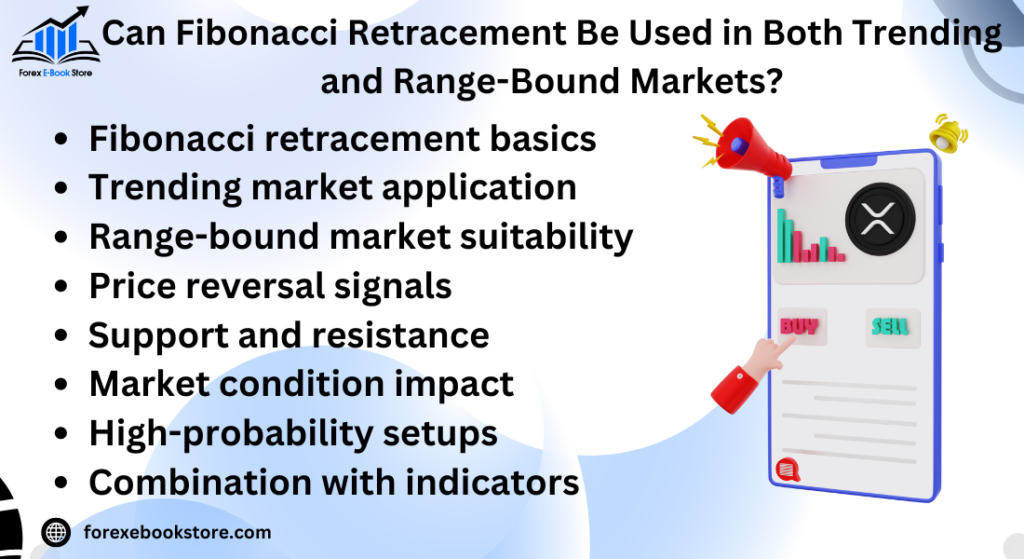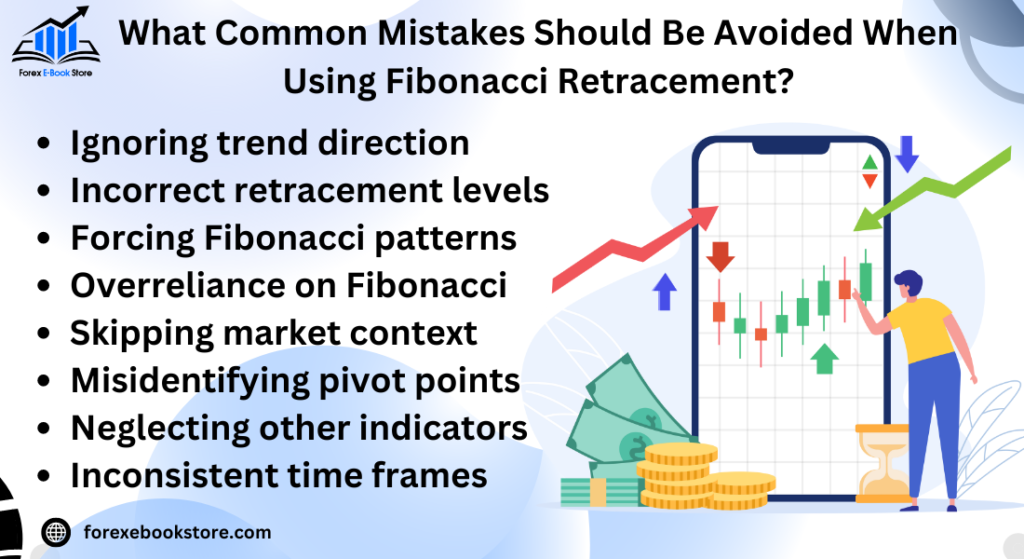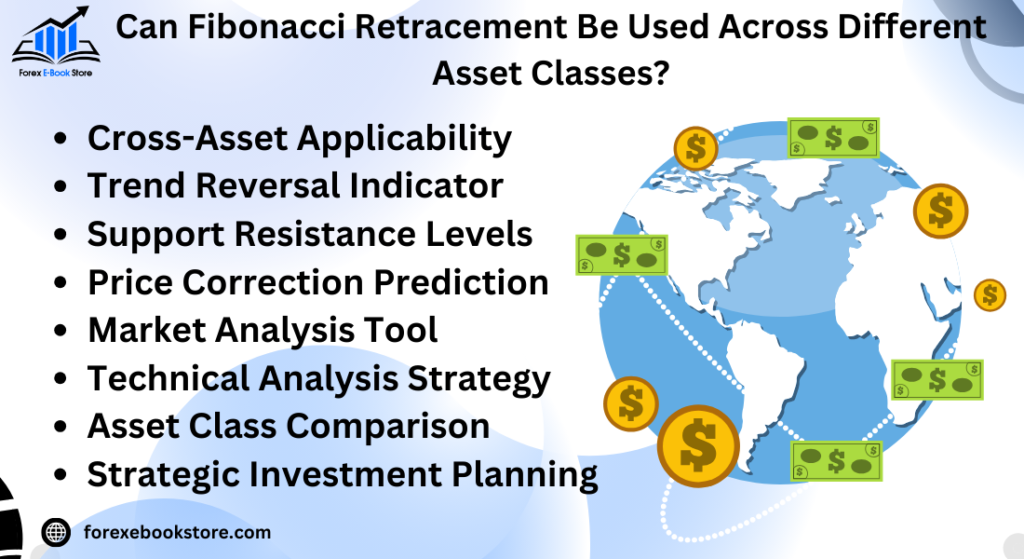In trading, identifying potential price reversal points is essential for making well-informed decisions. Using Fibonacci retracement is a popular strategy among technical traders to help predict areas of support and resistance. Based on mathematical ratios derived from the Fibonacci sequence, this tool provides insight into where price corrections are likely to end, making it invaluable in both trending and range-bound markets.
The Fibonacci retracement levels, such as 38.2%, 50%, and 61.8%, are often used to highlight possible reversal points in the market, giving traders a clearer picture of where to enter or exit a trade. These levels are widely applied in forex trading, stock analysis, and crypto trading, helping traders enhance their technical analysis and develop more effective strategies.
Table of Contents
What is Fibonacci Retracement, and How Does it Work in Trading?
Fibonacci retracement is a technical analysis tool that uses horizontal lines to indicate areas of support or resistance at the key Fibonacci levels before the price continues in the original direction. These levels are based on Fibonacci ratios: 23.6%, 38.2%, 50%, 61.8%, and 100%. Traders apply this tool to identify possible reversal points by measuring the peak-to-trough distance in a price movement.
The tool works by plotting these levels between two significant price points, typically a high and a low, on a price chart. The idea is that as the price retraces part of its original move, it will find temporary support or resistance near one of these key Fibonacci levels. For example, a trader might look for a bounce around the 38.2% retracement level in an uptrend before continuing to higher prices.
Key Concepts:
- Based on the Fibonacci sequence and key retracement levels.
- Helps predict support and resistance in price movements.
- Used by traders to identify potential reversal zones.
How to Set Up Fibonacci Retracement Levels on a Chart?
Setting up Fibonacci retracement levels on a chart is a straightforward process, but accuracy is essential for its effectiveness. Most trading platforms like MetaTrader and TradingView have built-in tools for drawing Fibonacci levels.
- Identify the High and Low Points: The first step is to identify the highest and lowest points of the price movement you are analyzing. In an uptrend, you’ll draw the Fibonacci retracement from the swing low to the swing high, while in a downtrend, you’ll draw from the swing high to the swing low.
- Apply the Fibonacci Tool: Once you’ve identified the relevant points, select the Fibonacci-retracement tool from your trading platform. Click at the starting point (either the low or high) and drag to the ending point. The retracement levels (23.6%, 38.2%, 50%, 61.8%, etc.) will automatically appear on the chart.
- Analyze the Levels: After applying the tool, you can analyze how the price reacts to the key levels. Typically, traders expect some consolidation or price reversal around these areas, giving clues about entry or exit points.
Setting Up Fibonacci Levels:
- Identify key price points (highs and lows).
- Use the built-in Fibonacci tool on trading platforms.
- Analyze how the price interacts with the Fibonacci retracement levels.
What Are the Key Fibonacci Levels Traders Should Know?
There are several Fibonacci levels that traders rely on to determine potential areas of support and resistance, but some are more commonly used due to their proven reliability.
38.2% Retracement Level: This is often seen as the first major level where a price might reverse. If the price pulls back by about 38.2% of its previous move, traders watch this level closely for signs of support or resistance. It’s particularly effective in strong trends.
50% Retracement Level: Although not officially a Fibonacci ratio, the 50% level is widely regarded as a critical psychological level. Many traders believe that a security often retraces half of its previous move before continuing its trend.
61.8% Retracement Level: Known as the “golden ratio,” the 61.8% retracement level is perhaps the most important. It represents a deeper pullback, and if the price holds at this level, it suggests that the original trend will likely resume. A break below this level often signals that a trend reversal is in play.
Key Fibonacci Levels:
- 38.2%: Early support or resistance.
- 50%: A common retracement level in all markets.
- 61.8%: The golden ratio, indicating deeper pullbacks and potential reversals.
How Do Fibonacci Retracement Levels Help Identify Support and Resistance?
Fibonacci retracement levels are valuable for identifying potential support and resistance areas, making them an essential tool in technical analysis. Traders often use these levels to predict where a price movement may slow down or reverse, offering critical insights into where to enter or exit a trade.

Support Levels: In an uptrend, Fibonacci retracement levels act as support levels when the price pulls back. For example, if a stock is trending upward and then experiences a retracement, traders might expect the price to find support near the 38.2% or 50% levels. If the price holds at these levels, it often indicates that the uptrend is likely to continue, presenting an ideal point for long positions.
Resistance Levels: Conversely, in a downtrend, the Fibonacci retracement levels act as resistance. As the price retraces upward during a pullback, traders look for resistance near the Fibonacci levels, particularly at the 61.8% level, which is often considered the most reliable for signaling a reversal back to the downside.
Key Points for Support and Resistance:
- Support in an uptrend when the price retraces to Fibonacci levels.
- Resistance in a downtrend when prices rise to retracement levels.
- Most common levels for support/resistance: 38.2%, 50%, and 61.8%.
When Should Traders Use Fibonacci Retracement in Different Market Conditions?
Using Fibonacci retracement in different market conditions can significantly enhance a trader’s ability to identify critical points of support and resistance, but its effectiveness depends on the specific market environment.
Trending Markets: Fibonacci retracement is highly effective in trending markets. In an uptrend, traders use retracement levels to identify points where the price might temporarily pull back before resuming its upward trajectory. Similarly, in a downtrend, Fibonacci levels are used to predict resistance where a temporary price rally may end, signaling an opportunity to re-enter short positions.
Range-Bound Markets: In range-bound markets, where the price is oscillating between fixed levels, Fibonacci retracement is less effective. However, it can still be useful when applied in combination with other technical indicators. For example, combining Fibonacci-retracement with support and resistance levels already established in the range can give traders additional confidence when entering or exiting positions.
Volatile Markets: In volatile or erratic markets, Fibonacci retracement levels might be breached more frequently, causing false signals. In such conditions, traders typically use wider retracement levels or pair Fibonacci-retracement with volatility indicators such as the Average True Range (ATR) to filter out noise and avoid premature entries.
Best Market Conditions for Fibonacci Retracement:
- Trending markets: Helps identify pullbacks for entries and exits.
- Range-bound markets: Can complement other indicators for confirming trade decisions.
- Volatile markets: Use with caution or in conjunction with volatility measures.
What Are the Advantages of Using Fibonacci Retracement in Technical Analysis?
There are numerous advantages to using Fibonacci retracement in technical analysis, particularly when combined with other tools and strategies. The ability to anticipate price levels where trends may reverse or consolidate makes it a favorite among professional traders.
Predictive Power: One of the main advantages of Fibonacci retracement is its predictive power. Unlike lagging indicators, which provide information based on past data, Fibonacci-retracement levels are forward-looking, helping traders anticipate future price movements. This allows traders to set up entry and exit points with better precision, improving trade timing.
Simplicity and Versatility: Fibonacci retracement is also widely praised for its simplicity. The tool can be used across various asset classes—stocks, forex, cryptocurrencies, and commodities—making it extremely versatile. Whether you are day trading or swing trading, Fibonacci-retracement can be applied consistently across different timeframes and markets.
Combines Well with Other Indicators: Fibonacci retracement works best when combined with other technical indicators, such as moving averages, RSI, or MACD. When multiple indicators align with a Fibonacci-retracement level, it increases the probability of a successful trade. This convergence gives traders greater confidence in their analysis.
Advantages of Fibonacci Retracement:
- Predictive power helps identify future support and resistance.
- Simplicity and versatility across multiple asset classes and timeframes.
- Works well in combination with other technical indicators for better accuracy.
How to Combine Fibonacci Retracement with Other Indicators for Better Accuracy?
Combining Fibonacci retracement with other technical indicators can significantly increase the accuracy of your trading strategy. This approach helps confirm potential reversal points and avoid false signals, providing a more reliable framework for decision-making.
Moving Averages: One of the most common tools paired with Fibonacci retracement is the moving average. For example, if a Fibonacci level aligns with a significant moving average, such as the 50-day or 200-day moving average, it reinforces the strength of that level as a potential support or resistance point. Traders often look for confluence between the Fibonacci retracement levels and moving averages to build confidence in their trades.
Relative Strength Index (RSI): The RSI is another valuable indicator to use alongside Fibonacci retracement. The RSI measures the momentum of price movements, indicating whether an asset is overbought or oversold. When an overbought RSI reading coincides with a Fibonacci resistance level, it could be a strong signal to exit or short a trade. Similarly, an oversold RSI reading combined with a Fibonacci support level could signal a good buying opportunity.
Combining Fibonacci with Other Indicators:
- Moving averages: Confirm support/resistance when they align with Fibonacci levels.
- RSI: Identify overbought/oversold conditions to strengthen Fibonacci signals.
- MACD: Use to confirm trend direction alongside Fibonacci retracement.
Can Fibonacci Retracement Be Used in Both Trending and Range-Bound Markets?
Fibonacci retracement is highly effective in trending markets, but traders also find it useful in range-bound markets when combined with other indicators. The tool’s versatility makes it a go-to for both environments, though its application differs slightly depending on the market type.

Trending Markets: In trending markets, Fibonacci retracement levels help traders identify potential pullback points during a trend. For instance, during an uptrend, traders might wait for the price to pull back to the 38.2% or 50% Fibonacci levels before taking a long position. This provides a high-probability entry point as the retracement levels often act as support before the trend resumes.
Range-Bound Markets: In range-bound markets, where the price moves between fixed support and resistance levels, Fibonacci retracement is less predictive on its own. However, traders can combine Fibonacci retracement with well-established horizontal support and resistance lines to pinpoint entry and exit points within the range. In this scenario, Fibonacci levels serve as additional confirmation, increasing the accuracy of trades within a defined range.
Using Fibonacci in Trending vs. Range-Bound Markets:
- Trending markets: Fibonacci helps identify pullbacks within the trend for better entries.
- Range-bound markets: Use Fibonacci alongside horizontal support/resistance for confirmation.
How Do Professional Traders Use Fibonacci Retracement in Day Trading?
Professional traders frequently rely on Fibonacci retracement as part of their day trading strategies to capture small but frequent price movements. The tool helps them identify intraday reversal points, allowing for quick entries and exits that align with short-term market fluctuations.
Intraday Reversals: Day traders often apply Fibonacci retracement to 5-minute, 15-minute, or 1-hour charts to identify key levels where price reversals are likely. For example, if an asset experiences a strong price movement, a trader might use Fibonacci retracement to find potential pullback levels at 38.2% or 50% of the original move. This provides an opportunity to enter the market during a brief retracement before the price continues in its original direction.
Scalping with Fibonacci: Some professional day traders use Fibonacci retracement for scalping, a high-frequency trading strategy that involves making small profits from minor price movements. Fibonacci levels, especially 23.6% and 38.2%, can help identify quick, short-lived pullbacks that allow traders to enter and exit positions within minutes, maximizing their number of trades throughout the day.
How Pros Use Fibonacci in Day Trading:
- Intraday reversals: Apply Fibonacci to short timeframes to identify pullback levels.
- Scalping: Use the 23.6% and 38.2% levels for rapid trades in high-frequency strategies.
- Combine Fibonacci with volume analysis to confirm intraday price movements.
How Can Fibonacci Extensions Complement Fibonacci Retracement?
While Fibonacci retracement helps identify potential pullback levels, Fibonacci extensions are used to predict potential price targets once the retracement is complete. Fibonacci extensions work beyond the 100% level of a price move and provide traders with a projection of where the market might go after a trend resumes, making them an excellent complement to Fibonacci retracement.
Setting Up Fibonacci Extensions: Fibonacci extensions are calculated by measuring the distance of a price move (from a low to a high in an uptrend or a high to a low in a downtrend) and applying Fibonacci ratios such as 127.2%, 161.8%, and 261.8%. These levels give traders targets for potential profit-taking or areas where the price might encounter resistance. For example, after a pullback to a 38.2% retracement level, traders might look to the 161.8% extension as a price target for their trade.
Using Extensions with Retracement: Many traders combine Fibonacci retracement and extensions to plan both their entry and exit points. For instance, a trader might enter a long position when the price retraces to the 50% retracement level and then set their exit at the 161.8% Fibonacci extension level, capturing both the retracement and the continuation of the trend.
Complementing Retracement with Extensions:
- Fibonacci extensions help predict price targets beyond the retracement.
- Common extension levels: 127.2%, 161.8%, 261.8%.
- Combine retracement for entries and extensions for exits to optimize trades.
What Common Mistakes Should Be Avoided When Using Fibonacci Retracement?
Although Fibonacci retracement is a powerful tool, it can lead to costly mistakes if not used correctly. Understanding the most common errors traders make can help improve the effectiveness of this tool and prevent unnecessary losses.

Over-reliance on Fibonacci: One of the biggest mistakes traders make is relying solely on Fibonacci retracement levels without considering other technical indicators or market conditions. While Fibonacci levels can provide important clues, they are not always guaranteed to hold as support or resistance. To improve accuracy, Fibonacci retracement should always be used in conjunction with other tools, such as moving averages, RSI, or trend lines.
Drawing Fibonacci Incorrectly: Another common error is drawing the Fibonacci retracement levels from incorrect price points. Traders must ensure that they are selecting the correct high and low points of a price move. For example, in an uptrend, the Fibonacci retracement should be drawn from the lowest point of the move to the highest point, and vice versa for a downtrend. Misplacing the levels can lead to misleading signals and poor trade decisions.
Common Mistakes with Fibonacci Retracement:
- Over-relying on Fibonacci without other indicators for confirmation.
- Incorrectly drawing Fibonacci levels from the wrong price points.
- Failing to account for market context or broader trend conditions.
How to Use Fibonacci Retracement for Entry and Exit Points in Trading?
Fibonacci retracement is commonly used by traders to identify optimal entry and exit points, allowing them to capture price moves with higher accuracy. By strategically placing trades at key Fibonacci levels, traders can optimize their risk-to-reward ratios and improve their overall performance.
Entry Points: One of the main uses of Fibonacci retracement is finding favorable entry points during a trend pullback. For instance, in an uptrend, traders might wait for the price to retrace to the 38.2% or 50% level before entering a long position. These levels typically act as support, allowing traders to enter the market at a lower price within a continuing trend.
Exit Points: On the flip side, Fibonacci retracement can also help determine exit points, particularly when combined with Fibonacci extensions. For example, after entering a trade at a retracement level, a trader might set their exit at the 161.8% Fibonacci extension. This provides a natural profit target based on the previous price action, maximizing the trade’s potential while reducing the risk of holding on for too long.
Using Fibonacci for Entries and Exits:
- Enter trades at key Fibonacci levels during trend pullbacks (38.2%, 50%).
- Exit using Fibonacci extensions (161.8%) as profit targets.
- Combine with other indicators for greater trade confirmation.
How Does Fibonacci Retracement Work in Forex Trading?
Fibonacci retracement is especially popular in forex trading due to the highly liquid and volatile nature of currency pairs. Forex traders use Fibonacci-retracement to identify potential entry points during price corrections and to establish exit points for profit-taking in trending markets. The ability to predict pullback levels in both trending and ranging forex markets makes Fibonacci-retracement an invaluable tool for traders in this space.
Identifying Reversal Zones in Forex: Forex pairs often experience significant fluctuations due to geopolitical and economic events. Fibonacci retracement allows traders to find reversal zones where the price might pull back before continuing in the original direction. For example, if a currency pair is in a strong uptrend, traders can use Fibonacci levels like 38.2% or 50% to find areas of support during pullbacks. If the price holds at these levels, it suggests that the uptrend is likely to continue, giving traders confidence in entering long positions.
Combining Fibonacci with Other Forex Tools: Successful forex traders often combine Fibonacci retracement with other technical tools, such as support and resistance lines, moving averages, and RSI. By layering Fibonacci levels with these indicators, traders can confirm potential reversal points and improve the accuracy of their trades.
Using Fibonacci in Forex:
- Helps identify support/resistance in currency pairs during retracements.
- Combines well with forex-specific tools like moving averages and RSI.
- Particularly useful in highly liquid and volatile forex markets.
What Tools and Platforms Support Fibonacci Retracement Analysis?
Numerous trading platforms and tools provide built-in support for Fibonacci retracement analysis, making it easily accessible for traders of all experience levels. These platforms often offer additional features that allow traders to customize Fibonacci levels and integrate them into their broader trading strategies.
MetaTrader 4/5: One of the most widely used platforms for technical analysis, MetaTrader provides a simple, user-friendly interface for drawing Fibonacci retracement levels on price charts. Traders can customize the Fibonacci levels, apply them to different timeframes, and pair them with other indicators like moving averages and MACD. MetaTrader also allows traders to set alerts when price reaches key Fibonacci levels, making it easier to monitor potential trading opportunities.
TradingView: Another highly popular platform, TradingView offers a more advanced set of charting tools for Fibonacci analysis. Traders can easily draw and modify Fibonacci-retracement levels and add tools like Fibonacci extensions to forecast price targets beyond the 100% retracement level. TradingView also has a strong social component, allowing traders to share and discuss their analysis with others in the community.
Key Tools for Fibonacci Retracement:
- MetaTrader 4/5: User-friendly, highly customizable Fibonacci retracement tool.
- TradingView: Advanced charting features, including Fibonacci extensions and social sharing.
- Other popular platforms: ThinkorSwim, cTrader, and NinjaTrader.
Can Fibonacci Retracement Be Used Across Different Asset Classes?
One of the major advantages of Fibonacci retracement is its versatility across different asset classes, including stocks, forex, commodities, and cryptocurrencies. Since the principles of Fibonacci-retracement are based on market psychology and natural ratios, they can be applied effectively to any asset that follows technical trends.

Stocks: In the stock market, traders often use Fibonacci retracement to find potential reversal points during price corrections. Whether they are trading individual stocks or indices, Fibonacci-retracement can highlight key areas of support and resistance where price action is likely to pause or reverse. This is particularly useful during earnings seasons when stock prices often experience sharp fluctuations.
Commodities and Cryptocurrencies: Fibonacci retracement is also widely used in commodities trading (such as oil, gold, and silver) and the crypto market. Given the high volatility of these markets, Fibonacci levels like 61.8% often serve as reliable points where prices find support or resistance before continuing their trends. The cyclical nature of commodities markets and the speculative nature of cryptocurrencies make Fibonacci-retracement highly effective for spotting potential price turning points.
Asset Classes for Fibonacci Retracement:
- Stocks: Identifies support and resistance during price corrections.
- Commodities: Used in volatile markets like oil and gold to find reversal zones.
- Cryptocurrencies: Helps navigate speculative and highly volatile crypto assets.
Conclusion
In conclusion, using Fibonacci retracement is a powerful strategy for identifying potential support and resistance levels in various markets, from forex and stocks to cryptocurrencies and commodities. By understanding key Fibonacci levels like 38.2%, 50%, and 61.8%, traders can make more informed decisions on where to enter or exit trades, especially during price corrections or pullbacks. When combined with other technical tools, Fibonacci-retracement becomes even more effective, offering a comprehensive approach to market analysis.
Similarly, traders using oscillators in forex can enhance their strategies by integrating Fibonacci retracement. Oscillators such as RSI or MACD help identify overbought or oversold conditions, and when these signals align with Fibonacci levels, the likelihood of price reversals increases. This combination of Fibonacci-retracement and oscillators provides a solid foundation for technical traders seeking to maximize their forex trading success.












